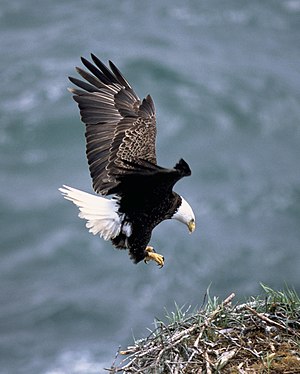- Bald Eagles have faced many perils since the 20th century, due mostly to human interactions. Though they have been on the 'endangered species' list, moved to the 'threatened' list and have been recovering well with breeding pair introductions in many states, they still have a long way to go to reach their previously estimated population sizes.
- The Bald Eagle lives throughout a large part of North America, primarily in the US and Canada, and is usually found near rivers and bodies of water.
-
Bald Eagles are opportunistic feeders and usually prefer to eat fresh fish. During winter, they will eat more birds, mammals and carrion. Image via Wikipedia
Image via WikipediaImmature Bald Eagle - Bald Eagles usually hunt from a high perch and glide down to catch their prey. They will strike from the air and are known to wade into shallow streams or rivers for fish.
- Bald Eagles are pulled into the water occasionally while trying to catch large fish and then, using their wings to mimic a motion that is similar to the butterfly stroke, break free from the water.
- Pairs perform dramatic aerial displays. The most impressive display involves the two eagles flying to great height, locking talons and then tumbling perilously toward the earth, breaking apart just before they would hit the ground.
- Bald Eagles generally mate for life. They renew their pair bonds each year by adding new sticks and branches to their massive nests in which they usually lay two to three eggs.
 Image via WikipediaBald Eagles have the largest nest of any North American bird and it can take months to build. Average nests measure about 5 feet wide and 3 feet tall and are made of sticks and branches. The biggest recorded Bald Eagle nest was about 9 feet wide and 18 feet tall.
Image via WikipediaBald Eagles have the largest nest of any North American bird and it can take months to build. Average nests measure about 5 feet wide and 3 feet tall and are made of sticks and branches. The biggest recorded Bald Eagle nest was about 9 feet wide and 18 feet tall. - Male Bald Eagles help the females incubate the eggs, and both care for the young after they hatch.
- Both parents are very careful around the eggs while in the nest. They will even clench their toes to possibly prevent the eggs from being punctured by their talons.
- Babies hatch in about 35 to 46 days and will leave the nest in 10 to 11 weeks. However, they will still be fed for a month after fledging.
- Juvenile Bald Eagles gradually spend time on their own away from their parents and learn to hunt by trial and error. They may eat a lot of carrion, especially fish, till they master hunting live food.
- Bald Eagles do not mature until their forth or fifth year, only then receiving their characteristic white head and tail plumage.
- Immature Bald Eagles have been known to explore vast areas for multiple years. Some Floridian young have been seen in Michigan, and some Californian young have gone as far north as Alaska.
Related Articles:
- Bald Eagle Information http://t.co/o4ugzs2
- Nesting Eagles http://t.co/vpj99ZV
- Mockingbird vs. Eagle Slide Show http://t.co/2uNNlqk
- Terrified Geese Have Eyes on the Sky http://t.co/pqsWQqE
- Amazing moment bald eagle chases down and catches a starling in mid-air http://t.co/U3CT5Sh
- Michigan DNRE asking drivers to watch out for bald eagles http://t.co/A9R33zI


No comments:
Post a Comment